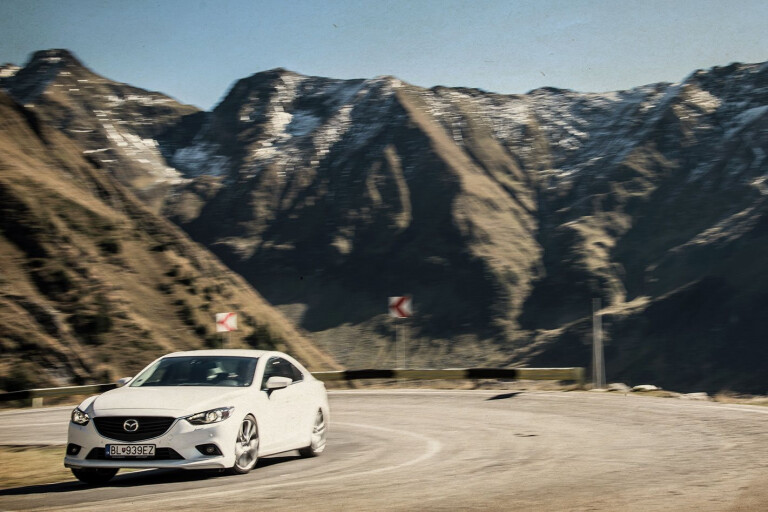
Sharp as a vampire’s fangs, but not nearly so neat and even, the Fagaras Mountains poke holes in the darkening Romanian sky. This small nation is known as the homeland of Dracula. Or, more accurately, where the historical figure used by the author who created the enduringly popular blood-sucker lived.
Romania isn’t a rich country, and the Dracula story is perhaps its most powerful tourist magnet. Unsurprisingly, they try to make the most of the connection.
But there’s much more to this little, and little-known, nation of Eastern Europe than dodgy links to Dracula. Romania is supposed to have some legendary driving roads. In the centre of the country are the Transylvanian Alps, which form the southernmost section of the Carpathian Mountains, a 1500km-long semi-circle of peaks extending clockwise from the Czech Republic through Slovakia, Poland and Ukraine to Romania.

Most likely for military reasons, Romanian leader Nicolae Ceausescu ordered the construction of a new road in the early 1970s. It was to wind its way through the Fagaras Mountains section of the Transylvanian Alps, providing a new link between Romania’s south and north. Threading its way between a maze of 2500m-plus peaks – taller than our Mount Kosciuszko – the Transfagarasan was completed in 1974, though it was years before it was all asphalted.
Ceausescu’s quarter-century reign came to a brutal end on Christmas Day 1989. After a brief military trial, he was executed by firing squad. It was a bloody end to the bloodiest of the revolutions that ended Communist regimes across Eastern Europe after the fall of the Berlin Wall.
Romania snuggled up close to Western Europe after the revolution. With the openness came tourists, who began to spread word of the country’s attractions, including the Transfagarasan Highway, which began to earn a reputation as a rival to Italy’s famed Stelvio Pass. Could this be true? The Stelvio is a road I know well. I’ve been over it on two wheels and four, and it ranks among the world’s most spectacular drives.
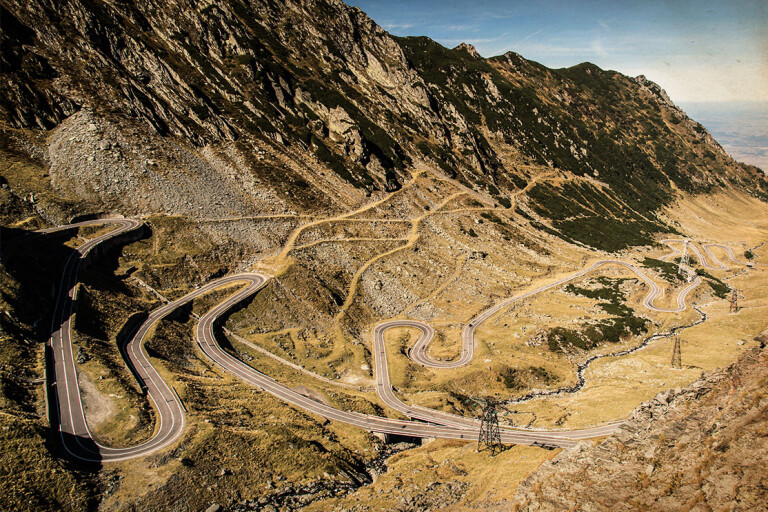
The Transfagarasan is the main reason we’ve flown into Romania’s capital, Bucharest, where a Mazda 6 is waiting for us. Now, heading for our overnight stay in the city of Sibiu, we can see the Fagaras Mountains on our left. In the late afternoon light, the jagged, snow-capped peaks appear toothy yet enticing.
Leaving Bucharest’s morning rush hour behind us, we head north on a multi-lane highway to Ploiesti. It’s not long before we overtake our first horse-drawn wagon. Romania may have grown wealthier in the quarter century since the end of Communist rule, but not everyone can afford to own a Dacia. Even a second-hand one.
Romania’s very own car brand has become a huge success story. Bought by Renault in 1999, Dacia now turns out more than 400,000 cars a year, mainly for export, and makes good money for its French owner. It enjoys a 30 percent-plus share of its home market, but had even more during the Communist years.
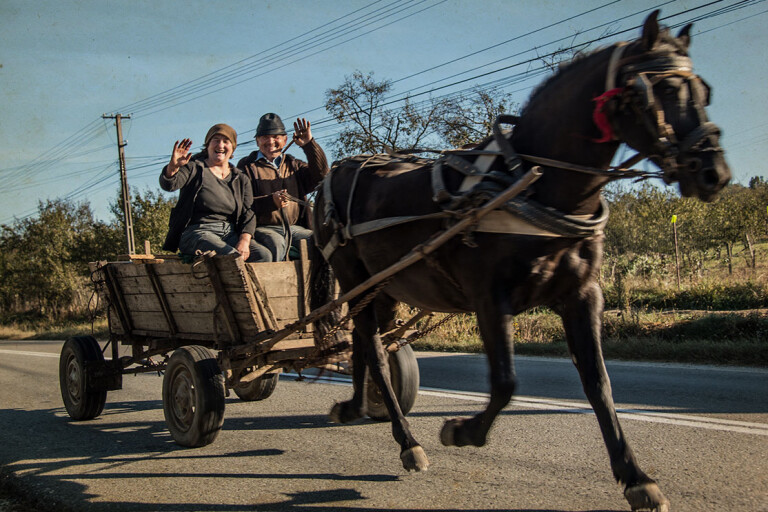
Most numerous are the licence-built Renault 12 copy that was in production for more than three decades from 1970. These things are survivors, and a step up from a horse-drawn cart, even one with pneumatic tyres.
Dodging Dacias, we drive into the centre of Ploiesti. This city 60km north of Bucharest is where, in 1857, the world’s first large-scale oil refinery was constructed. Romania beat the US into the big-oil business by two years. By luck, we stumble across Romania’s National Oil Museum. Many of the exhibits have a dusty, Communist-era feel about them, and Ploiesti these days doesn’t pump much black gold, but this was once gusher-ville.
English-speaking guide Gabriella explains that the area was well known as a source of oil for centuries before people began extracting it in large quantities. It literally seeped from the ground. Romania’s pioneering role in the industry meant that many early technical advances in oil extraction were invented here, including the valve that stops a gusher gushing.
But Ploiesti’s success made it a target. After first trying to remain neutral, Romania joined World War II in 1940 on the side of Germany. By 1943, the city’s refineries were estimated by Allied intelligence to be producing more than a third of the fuel used by Hitler’s armed forces. With Ploiesti pumping lifeblood into the Nazi war machine, the US Army Air Forces decided to drive a stake through its heart.

As a World War II aviation tragic, I know Ploiesti as the target of Operation Tidal Wave. This raid, in August 1943, was the most famous of the attacks against the city’s refineries. For all the wrong reasons.
After taking off from Libya, 162 four-engined B24 Liberators attacked nine refineries around the city, flying very low to improve bombing accuracy. It was a brave tactic, and an expensive one. Little more than half the aircraft made it back to Libya. Some landed in Turkey or Cyprus, many were shot down by German and Romanian fighter planes or anti-aircraft guns over Ploiesti and some crashed or were ditched as they struggled homeward. More than 300 American airmen died, the worst toll in any single USAAF bombing mission. The survivors called it Black Sunday.
But Operation Tidal Wave was a strategic failure, and so the bombing of Ploesti continued. According to our guide Gabriella, later high-level bombing destroyed much of the centre of the town.
No bombs have ever disfigured Bran Castle, 110km further north. It’s promoted as ‘Dracula’s Castle’, mainly because it looks perfect for the role. Or it would on a windy, wintry night with a full moon high in the sky. It’s a sunny afternoon when we arrive in the village of Bran.
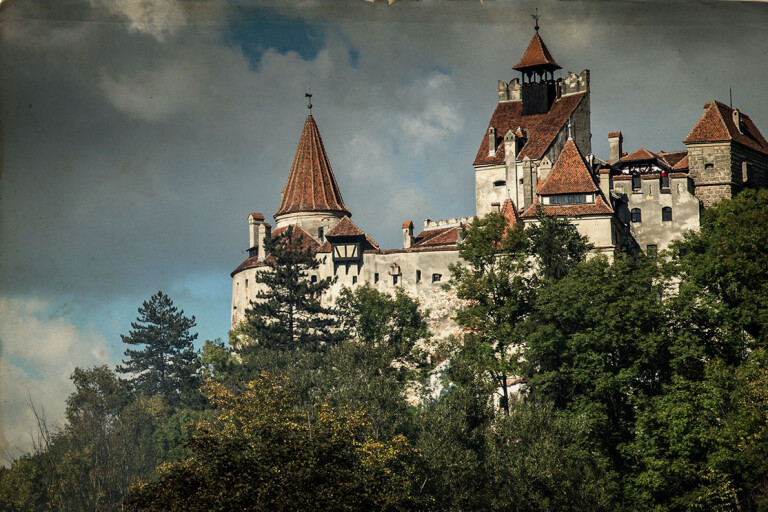
Mingling with flocks of noisy American and Chinese tourists, we tour the castle and browse the souvenir stalls around the entrance. Most offer a lot of Vampire-themed stuff, plus local crafts and foods.
Bran Castle’s links with Dracula are skimpy, to say the least. The author of the 1897 novel that kicked off the count’s career, Irish journalist, critic, theatre manager and writer of horror classics Bram Stoker never actually visited Romania. But the castle apparently is the only one in all of Transylvania that’s a close match with the book’s description of Dracula’s home.
Stoker certainly borrowed the name of Dracula for the central character of his best-known work, but there’s little resemblance between the world’s favourite vampire and the real-life 15th century nobleman named Vlad to whom it belonged. Dracul is Romanian for dragon, and young Vlad’s dad, also Vlad, was a member of the Order of the Dragon, a knightly fellowship sworn to defend Christianity. The old man became known as Vlad II Dracul because of his membership, the young ’un as Vlad III Dracula, or son of Dracul.
As ruler of Wallachia, the kingdom neighbouring Transylvania, Vlad III Dracula was a robust defender of his realm against invading Ottoman Turks. Despite being a good Christian lad simply doing his best in difficult times, he was posthumously given the terrible tag Vlad the Impaler. It’s possibly true he had thousands of his enemies impaled on pointy wooden sticks, an accepted means of execution at the time. Less certain is that he was fond of drinking blood, and he certainly did get around in daylight.
Our image of Dracula, then, is mostly the creation of Bram Stoker, who apparently planned to call his book ‘The Un-Dead’ until he heard the name Dracula from a Hungarian writer acquaintance with tales to tell from the Carpathian Mountains.
Next morning, having overnighted at Sibiu, we get closer to the Carpathians than Stoker ever did. It’s foggy as we head up the valley to the northern end of the Transfagarasan Highway, but the mist burns away as we approach the beginning of the climb.
It turns into a bright, clear day. And the road is magnificent. By the time we reach the top, I’m ready to declare the Transfagarasan Highway a better drive than the Stelvio Pass. There’s less traffic, which is an aid to driving enjoyment, but the twists and turns contribute more. This Communist-era creation flows more sweetly than the best bits of Stelvio. There’s more variety in the curves than the repetitive hairpins of Italy’s legendary pass.
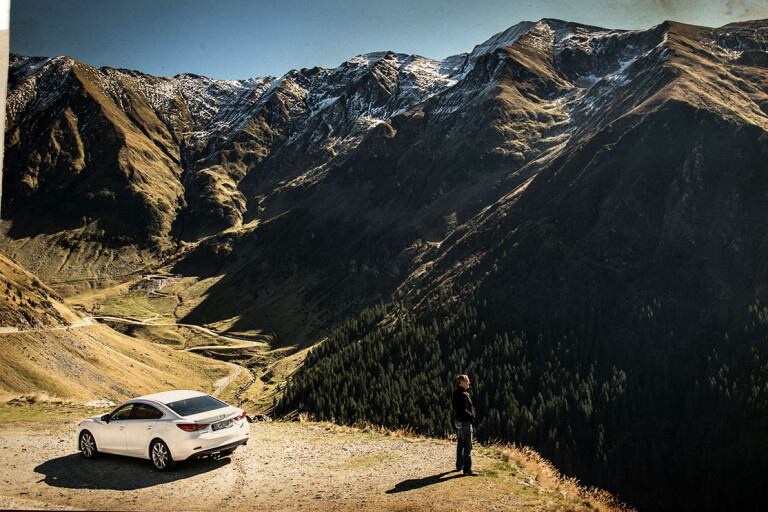
The 6 sedan seems to enjoy it, too. One of the reasons Mazda’s large-medium sedan remains a Wheels favourite is its fine handling. This is a car that works with, rather than against, a keen driver. It understeers a little both into and out of corners, but this slight degree of clearly signalled front-end slip isn’t troublesome. Instead, it’s an encouragement to push the 6 to its limit. Ours is a 2.5-litre auto. The 138kW 2.5-litre four makes it an enthusiastic climber and the six-speeder, which holds the selected gear no matter what, is the right kind of automatic for spirited driving.
The only disappointment of the drive is that, at the top, the Transfagarasan Highway tunnels about 800m through to the other side of the sharp-edged ridge. Consequently, the views aren’t quite as majestic as those from the open-air high point of the Stelvio.
A bunch of stalls are set up around the northern entrance, where there are remnants of snow in shady spots. I buy some mutton sausages from a stall run by a jokey young guy with some English. Butchery of the cured meats on display looks rather primitive, like the animals were pulled apart with tractors, but the sausage I’ve bought tastes good.
Having conquered the brilliant Transfagarasan, the plan is to head back down the way we came to tackle the only other road in Romania that’s higher. The Transalpina Highway tops the 2034m maximum altitude of the Transfagarasan by exactly 111m.
We head west through Sibiu, to Sebes at the northern end of the Transalpina, on what seems to be Romania’s newest freeway. But not long after beginning the Transalpina, I start to wonder if this is a good idea.
There are rock falls, road subsidence and bridges with half their surface removed to a rim-shattering depth of 10 to 15cm. In many places poorly filled-in trenches have been cut across the road. Diversions to get around major problems are often rough and ready.
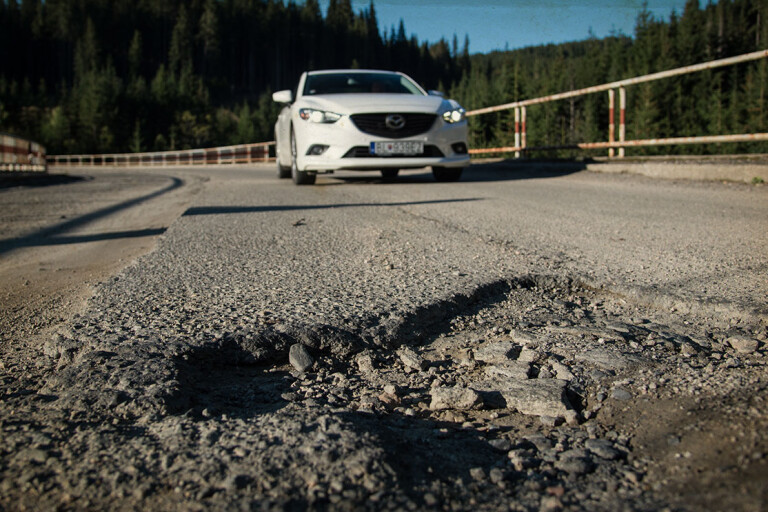
Later, I read on the informative Romanian-Insider website that the Transalpina isn’t actually finished and that a businessman described as Romania’s Asphalt King is being prosecuted for failing to complete work on the road he had been paid to do. You can get through, but only with care.
Our progress is slower than hoped, which means we reach the Transalpina’s high point at exactly the right time. The slanting afternoon sun bathes the grassy high country in a magical light. There are rustic-looking shepherds watching many sheep. And we’ve at last reached a section where the Asphalt King actually did some work.
But the sun goes down, and it’s after dark when we encounter a large flock of sheep being driven down the bitumen. Presumably they’re being brought down ahead of the autumn snows. In the Mazda’s bright headlights, the heaving, woolly mass looks surreal. A sprightly shepherd and his dogs move the sheep a little to one side so we can squeeze through.
It’s late when we reach our old-fashioned hotel in the arty area around the small town of Horezu. Tomorrow we must head down the motorway to Bucharest and return the Mazda 6 before catching homeward flights.
Our journey to Europe’s wild east has shown us that the Transfagarasan Highway truly is one of the world’s best and most beautiful roads. And if someone finishes what the Asphalt King has started, the Transalpina Highway may one day be its rival.
But Romania is a country with more to offer than memorable mountain passes. For me, Ploiesti was a highlight. It isn’t London or Leipzig, Hamburg or Hiroshima, but the refineries that still surround the city are a reminder that it was once a more worthy World War II target than any of these. From long-ago leaders like the prince called Dracula to more recent hard men like Ceausescu, many have left their mark on this small, Victoria-size nation.
Dacia, it seems to me, is the perfect metaphor for Romania today. This carmaker left behind a dreary past to transform itself, under Renault guidance, into a cost-competitive yet profitable brand.
Maybe they’ll one day produce something a young Romanian bloke might enjoy whipping up the Transfagarasan’s curves to his summit sausage-stall workplace. A hot hatch that bites like Dracula, but doesn’t suck, say. And it should have a name to hint at its place of origin. Chevrolet might even let them call it Impaler…
SNOW BUSINESS
Like alpine roads in Western Europe, Romania’s brilliant Transfagarasan and challenging Transalpina aren’t open all-year round.
June to October is the typical open season, although the Transfagarasan can close as late as November if snow comes late. Unseasonal snowfalls apparently can cause temporary closures of both, even in summer.
Although it’s shorter – 90km compared with the 148km of the Transalpina – the Transfagarasan is the pick if you have time for only one Carpathian high road. As a local told us: “The Transfagarasan is the pearl of Romania.”
DRIVE ROUTE
Our Romanian ramble was an anti-clockwise loop beginning and ending in the capital Bucharest, totalling around 900km. While there are some modern motorways, most of this route is two-lane road. These are often crowded, and the traffic mix includes horse-drawn carts and heavy trucks, but is mostly Dacias that refuse to die.
This article was originally published in Wheels March 2015.
COMMENTS